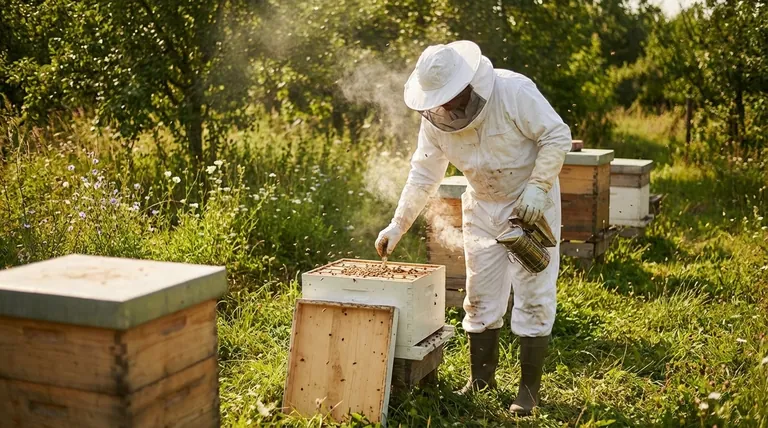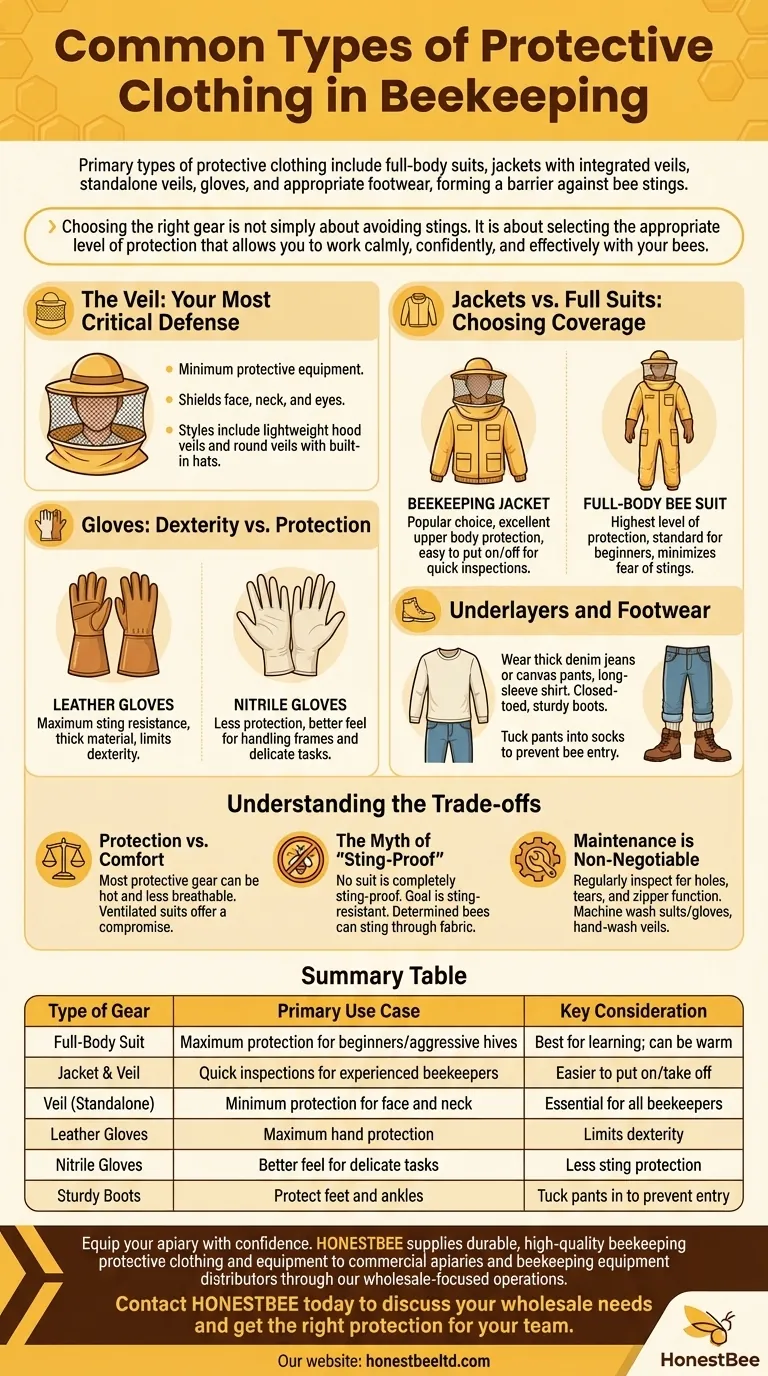The primary types of beekeeping protective clothing are full-body suits, jackets with integrated veils, standalone veils, gloves, and appropriate footwear. These components are designed to be used in various combinations to provide a barrier against bee stings, with the level of protection tailored to the beekeeper's experience and the temperament of the hive.
Choosing the right beekeeping gear is not simply about avoiding stings. It is about selecting the appropriate level of protection that allows you to work calmly, confidently, and effectively with your bees.

Core Components of Beekeeping Protection
Effective beekeeping protection involves covering vulnerable areas of the body. Each piece of gear serves a specific function, and they are often used together to create a comprehensive defense.
The Veil: Your Most Critical Defense
A bee veil is the absolute minimum piece of protective equipment you should wear. Its primary function is to shield your face, neck, and especially your eyes from stings.
Veils come in several common styles, including hood veils which are lightweight and foldable, and round veils which often have a built-in hat for structure and airflow.
Jackets vs. Full Suits: Choosing Your Coverage
A beekeeping jacket with an integrated veil is a popular choice that provides excellent protection for the entire upper body. It is easier to put on and take off than a full suit, making it ideal for quick hive inspections.
A full-body bee suit offers the highest level of protection, covering you from your ankles to your neck. This is the standard recommendation for beginners, as it removes the fear of stings and allows you to focus on learning.
Gloves: Dexterity vs. Protection
Beekeeping gloves protect your hands, a common target for stings. Traditional gloves are made of thick leather to provide maximum sting resistance, though they can limit dexterity.
Many experienced beekeepers prefer using disposable nitrile gloves. While offering less protection, they provide a much better feel for handling frames and observing the bees.
Underlayers and Footwear
What you wear under your suit matters. Choose thick denim jeans or canvas painter’s pants and a long-sleeve shirt.
Always wear closed-toed, sturdy boots. It is critical to tuck your pants into your socks or use boot bands to prevent bees from crawling up your legs.
Understanding the Trade-offs
Selecting beekeeping gear involves balancing competing priorities. Understanding these trade-offs is key to making an informed decision.
Protection vs. Comfort
The most protective gear is often the heaviest and least breathable. Working in a thick, non-ventilated suit on a hot day can lead to overheating and fatigue, which increases the chance of making mistakes.
Modern ventilated suits offer a compromise, providing excellent protection with better airflow.
The Myth of "Sting-Proof"
No bee suit is completely "sting-proof." A determined bee can sometimes get its stinger through the fabric, especially at tight spots like the knees or elbows. The goal of protective clothing is to be highly sting-resistant and prevent mass stinging events.
Maintenance is Non-Negotiable
Your gear is only effective if it's in good condition. Regularly inspect suits and veils for any holes or tears, and ensure all zippers and Velcro closures are fully functional. A small opening can compromise the safety of the entire suit.
Most suits and gloves can be machine washed, but veils should be hand-washed to avoid damaging the mesh.
Making the Right Choice for Your Goal
Your ideal gear configuration depends directly on your experience, the temperament of your bees, and the task at hand.
- If your primary focus is learning and building confidence as a new beekeeper: Start with a full, ventilated bee suit to minimize distractions and fear of stings.
- If your primary focus is conducting quick hive inspections as an experienced keeper: A quality jacket and veil combination often provides sufficient protection without the hassle of a full suit.
- If your primary focus is maximum dexterity for delicate tasks like queen marking: Consider using nitrile gloves, but only once you understand your bees and accept the higher risk of hand stings.
Ultimately, selecting the right protective gear empowers you to be a calm and effective steward for your colonies.
Summary Table:
| Type of Gear | Primary Use Case | Key Consideration |
|---|---|---|
| Full-Body Suit | Maximum protection for beginners or aggressive hives | Best for learning; can be warm |
| Jacket & Veil | Quick inspections for experienced beekeepers | Easier to put on/take off |
| Veil (Standalone) | Minimum protection for face and neck | Essential for all beekeepers |
| Leather Gloves | Maximum hand protection | Limits dexterity |
| Nitrile Gloves | Better feel for delicate tasks | Less sting protection |
| Sturdy Boots | Protect feet and ankles | Tuck pants in to prevent entry |
Equip your apiary with confidence. HONESTBEE supplies durable, high-quality beekeeping protective clothing and equipment to commercial apiaries and beekeeping equipment distributors through our wholesale-focused operations. Our gear is designed to keep you safe, comfortable, and productive. Contact HONESTBEE today to discuss your wholesale needs and get the right protection for your team.
Visual Guide

Related Products
- White Beekeeping Protective Suit and Hat with Fencing Veil for Beekeepers
- Cotton Beekeeping Suit and Round Hat with Veil Bee Keeper Protective Gear
- Heavy Duty Cowboy Beekeeper Hat with Visibility Veil Outdoor Professional Beekeeping Protective Gear
- Professional Beekeeping Suit for Kids and Girls Childrens Bee Keeper Suit
- Beekeeper Cowboy Hat and Veil for Beekeeping
People Also Ask
- What is the recommended maintenance for beekeeping protective clothing? Extend Gear Life & Safety
- Why is it important to choose protective clothing with some freedom to move around? For Unrestricted Safety & Efficiency
- What are the main types of protective clothing worn by beekeepers? Choose the Right Gear for Maximum Safety
- How do beekeepers not get stung? Master Bee Behavior & Protective Gear
- Why is white the predominant color in bee suit designs? | Key to Hive Calm & Beekeeper Safety



















